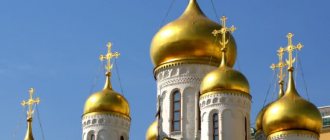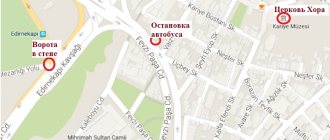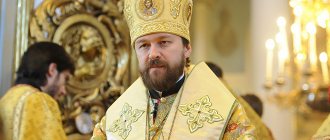What is the ROC?
The largest number of believers among the Local Orthodox Churches is the Russian Orthodox Church (abbreviated as ROC, another name is the Moscow Patriarchate). Until the 20th century, it was also called the “Russian Orthodox Church”, “Greek-Eastern Russian Church”, “Greek-Russian Church” and so on. It is important for every Orthodox Christian to know what the Russian Orthodox Church is.
St. Basil's Cathedral is the most famous temple of Russian Orthodoxy
“Studying the history of the Russian Church helps us, firstly, to remain in the Church, to be faithful to its Tradition; secondly, to live in the Church, that is, to grow spiritually ourselves, and also to teach the people of God.
There is always interest in the object of love, you want to know more and in more detail about it. If we love our Church, then we will study its history not out of duty, but out of love” (hieromonk Tikhon Vasiliev).
Metropolitan Alexy. The Heart of Monasticism
At the age of nine, Dmitry Ivanovich becomes the Grand Duke of Moscow. His ancestors left him a rich “economy” as a legacy: many cities and lands that gradually grew richer and rose from the heavy burden of Horde pogroms and unbearable extortions. While Prince Dmitry Ivanovich was growing up, all important matters were dealt with by the boyar government and Metropolitan Alexy. They acted in good unity.
Without Alexy's political tact and at the same time without his firmness, Muscovite Rus', under the blows of external enemies, could have lost its internal connections, disintegrated, and lost the strength that its unity gave it. And if not for his piety, Russian monasticism of those times would not have experienced an unprecedented rise.
Metropolitan Alexy as a politician enjoyed enormous influence in Moscow. He was allowed to conclude treaties on peace and war, and even begin fortress construction. The saint consistently acted in favor of Moscow. It happened that he even excommunicated political opponents of the Grand Duke of Moscow from the Church. This course is partly explained by Alexy’s desire to prolong the stable existence of the Moscow principality - after all, it was there that the metropolitan see was now located! Any wars, riots, devastation in Muscovite Rus' could call into question the calm and serene existence of the Russian Church. But there are other reasons: there is nothing good in strife from the point of view of Christian morality; the presence of a powerful center of unity in Moscow saved Rus' from endless inter-princely “irritation” and “dislike”; By supporting Moscow, Saint Alexy maintained peace. The Metropolitan was a supporter of peaceful relations with the Horde. He visited the Horde twice and performed a miracle there - he healed Khansha Taidula from blindness, thereby gaining favor with the Orthodox Church from her son, Khan Janibek.
In addition, Saint Alexy began a major monastic reform. Until the middle of the 14th century, most Russian monasteries, as a rule, were maintained at the expense of the founder (ktitor). Such ktitors could be, for example, great and appanage princes and boyars. Of course, they could have the widest influence on the monastic life of the monasteries. The large “dormitory” monasteries, independent of ktitors from the times of pre-Mongol Rus', were forgotten. The monks each lived in their own cell, dressed and ate according to their personal income. The founders of such monasteries could find there a quiet place for pilgrimage, for rest from business in their old age, and even for a family burial vault.
But in the middle of the 14th century the situation changed. The Moscow Metropolitan See returned the fate of Russian monasticism to its original course. In the new monasteries (and above all, in the Trinity Monastery of Abbot Sergius of Radonezh), a cenobitic or, in other words, “cinnovial” charter of monastic life is being introduced. This charter is stricter than the “exclusive” one that flourished in Russian monasteries of that time. In accordance with it, all the property of the monastery belonged to the monastic community headed by the abbot. Monks were not supposed to have their own property. They ate their meals at the same table, their clothes did not differ in any way. All of them were equal before the authority of the abbot and the “elders” - the monks who had the greatest spiritual authority. The community could be larger or smaller: up to two hundred or more monks. But in all cases, monasticism accounted for a lot of manual labor (“handicrafts”) and worries about the livelihood of the entire community. The number of new cinenial monasteries grew rapidly. In the 15th century, monasteries with a “special” or “Keliot” structure lost their numerical superiority to them. And the spiritual and political influence of cenobitic monasteries significantly exceeded the influence of their predecessors. Monasteries were outposts of high culture in wild, undeveloped lands, paramount centers of painting and book learning. Monasteries also became centers of Orthodox missionary work, and they could also play the role of fortresses - the main bases of resistance to the enemy in wartime.
In the 14th century, one of the most important, most striking processes in the historical fate of Rus' began: the monastic colonization of the northern and eastern outskirts of the country. But first of all, Muscovite Rus' was filled with monasticism - a poor wooded region, a former Cinderella among the regions of Ancient Rus'. A land devoid of ancient history, ancient traditions. For a very long time she remained poor in monasticism, poor in significant monasteries. But in just a few decades everything has changed. The small area around Moscow unexpectedly became the center of Orthodox monasticism of pan-European significance. It was an incomparable outburst of spiritual energy!
The 14th century rewarded Muscovite Rus' immeasurably: being a spiritual beggar at its dawn, by the end of the century it had become richer than all its neighbors in the ringing metal of holiness.
Local Churches as parts of the One Church of Christ
Since its inception, the Christian religion has been actively preached in many countries and peoples. Already in the first centuries, five Local Churches were formed - Jerusalem, Antioch, Alexandria, Rome, Constantinople. The Roman Church eventually subjugated the entire Christian West and left the family of Orthodox Churches. Now it is the Roman Catholic Church, professing the Catholic version of Christianity.
The remaining Local Churches, equal among themselves, continued to follow the dogmas of Orthodoxy. Over time, the number of these Churches increased. Often their borders coincide with the state and administrative borders of the countries on whose territory they historically developed. Their rituals and customs reflect preserved national characteristics.
Currently there are 15 Local Orthodox Churches. All of them are recognized as equal and autocephalous, that is, independent of each other.
In the Orthodox world there is an approved list of Churches, which is called a diptych. In it, Local Churches are ranked according to the “rank of honor” - taking into account their origin, declaration of autocephaly and the significance of the city centers.
The Church of Constantinople is considered senior in honor and first among equal Local Churches. The Russian Orthodox Church is the fifth Local Church in the diptych. According to the order indicated in the diptych, the primates of the Local Churches stand at the throne in the altar during joint services.
Russian Orthodox Church: history from the Baptism of Rus' to Peter I
The Kiev Metropolis was formed by the Church of Constantinople immediately after the Baptism of Rus in 988. After the destruction of Kyiv by the Mongols in the 13th century, the see of the Metropolitan of Kyiv was moved to Moscow. A new round in the history of the Russian Church began in 1448 after the convening of the first Moscow Council. At it, the Russian hierarchs independently (without the intervention of the Church of Constantinople) decided to elect the Ryazan Bishop Jonah as the primate of the Russian Church. The reason was that the Patriarchate of Constantinople concluded the Ferraro-Florentine Union (1438-1445) with Rome. This step meant the death of the Byzantine Empire as a stronghold of Orthodoxy.
In 1589-1593, Moscow metropolitans received the right to be called patriarchs. The Russian Church became independent in governance from other Local Orthodox Churches.
In the mid-17th century, a split occurred in the Russian Orthodox Church due to the church reforms carried out by Patriarch Nikon (1605-1681). Believers who did not recognize these reforms were declared heretics. This is how various Old Believer (schismatic) movements arose.
Synodal period
In 1700, Tsar Peter I prohibited the election of a patriarch. Church-wide governance was carried out by the Spiritual College, which was later renamed the Holy Governing Synod. The actual administration of the Church belonged to the emperor. Church institutions received their contents from the state treasury.
In 1764, Empress Catherine II closed many monasteries, which were mostly empty. The state seized part of the church property for its own benefit.
During the First World War (1914-1918), the Russian Orthodox Church actively provided assistance to the army and navy. Many monasteries opened hospitals for the wounded and shelters for orphans of dead soldiers.
By this time, many problems had accumulated in the internal church life. It was necessary to change the existing Synodal management system. The question arose about the revival of the patriarchate.
Revival of the Patriarchate and the Soviet period
In August 1917, the All-Russian Local Council was held in Moscow, which decided to revive the Russian patriarchate. Metropolitan Tikhon (Bellavin) of Moscow was elected Primate of the Russian Orthodox Church. However, after his death in 1925, the Soviet authorities did their best to prevent the election of a new primate of the Church. This is how a locum tenens (that is, temporarily acting) of the patriarchal throne appeared in the Russian Orthodox Church
Russian Orthodoxy suffered severe trials in the 20-30s of the last century. The policy of the state was to destroy Orthodoxy as a religion. A large number of clergy and believers were shot or exiled to camps. In 1937-1938 alone, 46,820 “ministers of religious cults” were arrested. All religious education was prohibited.
The situation changed somewhat during the Great Patriotic War. With the permission of Stalin, a Council was held in 1943, which elected the Primate of the Church, Sergius of Stragorodsky. In 1944-1947, with the knowledge of the authorities, 1,270 Orthodox churches were opened throughout the country.
In 1965, there were 16 operating in the USSR (in 1914 there were 1025). With the beginning of the Perestroika era (mid-1980s), the state's attitude towards the Russian Orthodox Church began to change. Many former church buildings began to be returned to the use of dioceses. So, in 1988, there were 8,500 active parishes in 76 dioceses throughout the USSR.
Russian Orthodox Church in our time
Today, the canonical territory of the Moscow Patriarchate extends beyond the state borders of Russia. Parishes and dioceses of the Russian Orthodox Church are registered in many countries around the world. The largest denominations in terms of the number of believers are in five countries: Russia, Belarus, Ukraine, Moldova and Latvia.
The Belarusian Exarchate (Belarusian Orthodox Church) is part of the Russian Orthodox Church. An exarchate (from the Greek “ἔξαρχος” - “external power”) is a large church region located outside the country. Her viceroy is located outside the metropolis. The election of the head of the exarchate is carried out by the Holy Synod of the Russian Orthodox Church and is appointed by the Patriarch of Moscow and All Rus'.
The Churches of Latvia, Estonia and Moldova have their own authorities and primates, whose candidates are approved by the Patriarch of Moscow and All Rus'. Decision-making on the establishment of dioceses, defining their boundaries and electing bishops in self-governing Churches is also carried out by the Patriarch and the Holy Synod of the Russian Orthodox Church.
The Ukrainian Orthodox Church of the Moscow Patriarchate (abbreviated UOC-MP) has the right of broad autonomy in the Russian Orthodox Church. It has its own primate and Charter, subject to approval by the Patriarch of Moscow and All Rus'.
The Russian Orthodox Church includes the Japanese and Chinese Autonomous Churches.
Metropolitan Peter. Seed of Holiness
The Moscow princely house was very difficult to climb. He rarely gained strong allies. And then the descendants of Daniel of Moscow dreamed of making the Church their ally and well-wisher.
When Metropolitan Peter came to Russian land, Moscow Prince Ivan Kalita managed to become his main comrade-in-arms, almost a friend. During a large church congress in Pereslavl-Zalessky, supporters of Tver attacked the “newcomer” saint, trying to overthrow him from the pulpit and clear the way for their man, and Ivan Danilovich defended him. Later, in order to attract the metropolitan to Moscow, he built a large stone cathedral - the Assumption Church in the Kremlin. Peter found his final resting place under the arches of the still unfinished church and thereby symbolically moved the metropolitan residence from Vladimir to Moscow. Some historians associate the name of Metropolitan Peter with the emergence of the famous VysokoPetrovsky Monastery, which would later become a center of spiritual enlightenment. At the dawn of its historical destiny, the Vysokopetrovsky Monastery was a monastery near Moscow. As, indeed, were other large monasteries that surrounded pre-Petrine Moscow with precious beads: Spaso-Andronikov, Danilov, Simonov, Novospassky and even their later brother - Novodevichy. All of them were located in the suburbs, all of them could become the centers of independent cities, like the Trinity-Sergius Lavra. They all lived a secluded life, devoid of city noise and bustle. And only centuries after their appearance, the city limits of Moscow moved, and they became part of the Russian capital.
With the advent of the new metropolitan, Theognostus, the building of good relations had to begin anew. An imperious and independent politician, Theognost did not immediately become a friend of the Moscow princely house. But in the end, this metropolitan brought a lot of benefit to Moscow. Monuments to Ivan Danilovich’s continuous struggle for metropolitan favor, in addition to the Assumption Cathedral, were the stone churches of the Apostle Peter and John Climacus (in the Kremlin), the Church of the Savior on Bor, and the Kremlin Archangel Cathedral. None of these buildings have survived to this day. The last of them, Spas na Bor, was barbarically destroyed by the Bolsheviks. But in the middle of the 14th century, all of Rus' watched in amazement as young Moscow was decorated with stone architecture more magnificent than the ancient cities of Suzdal.
The chronicle calls Ivan Danilovich “God-loving” and “mice-loving.” These words correspond both to his politics and to the natural make-up of his personality.
The most ancient Moscow princes, and Kalita in the first place, valued good relations with the Church as the greatest treasure. But... we need to see more than just politics here. Yes, the relations between Moscow rulers and metropolitans contained a lot of politics, but this did not exhaust the fullness of the union of secular power and spiritual power.
Through the wise metropolitan scribes who came from Constantinople and the South Slavic countries to the lands of impoverished, ruined, humiliated Rus', high culture flowed like a blessed stream. With them came new theological ideas. They could call experienced church painters to Rus'. The spirit of the ancient monastic schools of Athos and other holy places of the Orthodox East followed them to the north. The Moscow land, which, thanks to the brilliant church policy of Ivan Kalita, found itself in special proximity to this life-giving source, seemed to have received an unquenchable lamp in its heart. Since the time of St. Metropolitan Peter, the great ascetic and icon painter, the destinies of Moscow Rus' were as if... illuminated from within. Under the influence of her radiance, many things were ennobled in hearts and souls.
Only a few decades have passed since the time when Metropolitan Peter connected his life with Moscow, and the seed that fell into the soil of the fragrant, resinous region turned into a fruitful tree. The holiness of Muscovite Rus' began to bear fruit abundantly in the era of Dmitry Donskoy.








